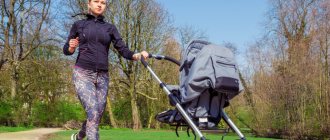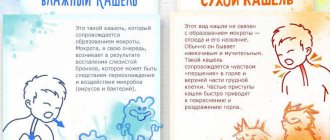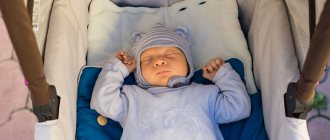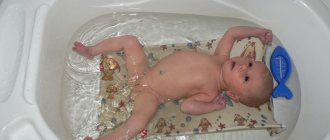Is it possible to walk with a child with a fever, expert opinion
It is believed that an increase in body temperature is an alarming symptom, meaning that the child is sick.
But, according to experts, everything is not so simple:
- An increase in temperature above 37.7 degrees indicates that a malfunction has occurred in the body, it is likely that the baby is sick, but it is worth assessing his general condition.
- If a child has all the signs of intoxication, he is weak, capricious, refuses food, sleeps a lot, then it is better to skip the walk.
Doctors believe that you can walk with your baby, but under certain circumstances:
- when the temperature outside is comfortable, there is no extreme heat or cold, wind, or rain;
- when the baby eats well, does not refuse food and water, and feels well, despite elevated body temperature;
- when the child is on the mend and the crisis has already passed, but provided that the weather outside is favorable.
You should not go outside if you have allergies; contact with allergens can aggravate unpleasant symptoms. Lead to improved performance.
If you take your baby outside too early, when he is not yet ready for this, then there is a high probability of developing serious complications. A cold can result in pneumonia, pyelonephritis and other serious diseases.
Walking as a method of treatment in the fresh air
There are a number of diseases that can be treated by walking in the fresh air. Most diseases are treated in this way not during the period of exacerbation, but during the transition of an acute condition into stable remission.
It is not prohibited to walk when:
- A cold or viral disease was diagnosed, and it has subsided, the temperature has decreased, and does not rise above 37.5 degrees.
- The child has breathing problems and has developed bronchitis as a result of an acute respiratory infection or acute respiratory viral infection. In this case, staying in the fresh air will help avoid fluid stagnation in the lungs.
- A runny nose and cough are not considered a reason to refuse to go outside, but do not forget that they may indicate that complications of ARVI or acute respiratory infections have begun.
If the baby has recently suffered from pneumonia, severe stress, or suffers from headaches, then walking will not harm him. But you should follow certain rules:
- You should start walking for 15 minutes, gradually increasing the time you spend outside;
- if the baby feels unwell, then refuse to go out and reschedule it for another day;
- don’t force your child, if he doesn’t want to go out, then stay at home.
What to do at the first signs of a cold: how to alleviate the condition
When the baby has recently recovered from a serious illness and his body is still weak, it is better not to go outside, but to provide the child with comfortable conditions within the walls of the house.
This will help strengthen the immune system, avoid the disease becoming chronic, and will not cause complications.
If your baby has symptoms of acute respiratory viral infection or acute respiratory infections and has an elevated body temperature, then you should not visit crowded places: shops, shopping centers, cinemas. In such large rooms, viruses and pathogenic bacteria accumulate. Upon contact with which the child may become ill again.
The infection will quickly affect a weakened body that has not had time to recover from a cold or flu.
At what temperature can you walk outside with your child?
Plan to visit the street if your baby has a slightly elevated body temperature.
If you have a runny nose or cough, but your health has not changed significantly, then you can go for a walk, provided that the reading does not rise above 37.5 degrees during the day.
If the temperature is above this level, heat transfer is disrupted. When going outside, the baby will begin to freeze and feel discomfort.
A high temperature also indicates that the body is actively resisting viruses and bacteria, which means it is wasting energy. You should not take long walks in this state, they will weaken the patient even more.
If parents nevertheless decide to visit the street with their offspring, then they should pay attention to:
- How and what the baby is wearing. Hypothermia will lead to the development of complications, while overheating will cause an increase in body temperature.
- How much water does the patient consume? Lack of fluid will cause dehydration, which means it will increase the chances of overheating and fever. If your child sweats, increase the amount of fluid, because sweat removes toxins.
- On the degree of activity. During illness, children are depressed, but not always. Increased stress weakens the body, limit activity, carry your baby in a stroller, on a sled, and do not let him walk. Or shorten the beep time.
- Do not visit the beach in the heat, do not let the sick person near the water. Avoid walking if it is too cold or windy outside.
In windy weather, children have difficulty breathing; such problems are aggravated if there is a cough or shortness of breath associated with dysfunction of the respiratory system.
Is it possible to walk with a low-grade fever?
If your body temperature rises to 37-37.5 degrees during illness, you need to pay close attention to your health. During the cold season, during the winter or autumn months, you should be careful when outdoors.
The fact is that cool ambient temperatures can provoke spasm of skin blood vessels, which leads to a decrease in heat loss and an increase in the temperature of internal organs. However, this condition has a very harmful effect on human health, creating an increased burden on the body.
Thus, you can walk in the cold season up to a threshold body temperature of 37.5. If the temperature rises higher, going outside is not recommended.
Also, while walking, a person sometimes spends a lot of energy on active movements, especially in the cold season. Doctors advise directing available energy to protect the body from bacteria and viruses, rather than to physical activity.
In hot weather, the situation can be aggravated by the sun's rays, which additionally heat the body. Thus, a person, being under the influence of solar activity, exposes his health to danger; the heat can increase body temperature to critical heights.
In the summer, if you have a cold with a fever, you can only walk in the evening in a dark place, away from the sun's rays.
It is important to understand that an increase in temperature to 37 degrees and above is primarily a protective reaction of the body, resulting in the production of antibodies that fight the disease, the main thing is that this is not yet a high temperature.
If everything goes without complications, the patient will be able to return to his normal lifestyle in a few days.
But you need to treat your health thoughtfully and carefully, only in this case the disease will pass easily and quickly.
When can you walk with your child after a fever?
Pediatricians believe that it is possible to walk with a child if the temperature is not high. You will have to stop walking if:
Signs of a cold in an infant, symptoms and safe treatment
| The indicator is not stable | The temperature changes, which affects the patient’s well-being |
| Poor sleep or poor appetite in the child. | This reduces its protective functions. |
| The doctor prescribed antibiotics and is taking them. | When carrying out such therapy, it is better to stay at home. |
| The intoxication of the body remains, but there is no fever. | This indicates that the body has not recovered from the infection, and it has become chronic, which is fraught with complications. |
| The indicator decreased, but the state of health did not improve. | When your baby still doesn't feel well, don't take him outside. |
Walks are allowed if:
- they were approved by the pediatrician who monitored the patient’s condition;
- the temperature has subsided, and the baby is recovering, eating well and sleeping soundly;
- there are no signs of intoxication, the main symptoms of the disease have subsided;
- The baby expresses a desire to take a walk in the fresh air.
It is believed that walking is prohibited until complete recovery. This opinion is partly true, since if you take a fragile child outside, there is a high risk of encountering complications of the disease. And they can be dangerous to his life and health.
But if the patient’s body successfully copes with the disease, then walking is possible and even necessary. Many doctors say so.
Contraindications for walking
- In cool weather and strong winds, it is better to avoid walking. Otherwise, capillary spasm can further increase body temperature.
- It is best to stay home if you have a severe runny nose. You should also not go for a walk if a person is taking medications against colds, which causes excessive sweating.
- You should not go outside if you have an acute cough. To ensure a lack of fresh air, it is recommended to ventilate the room in which the patient is located as often as possible.
During a walk, you must immediately go home if the patient suddenly becomes thirsty, this is the main sign of an increase in temperature. You also need to return to the room if the patient is cold and feels chills. You should act in the same way for any discomfort. The video in this article will tell you how to walk with a fever.
How to dress a child outside if he has a slightly elevated temperature?
Clothing is considered a “stumbling block”, because it is impossible for a child to overheat, suffer a sharp temperature change or experience hypothermia. All these conditions are potentially dangerous and can aggravate unpleasant symptoms. So how to dress a baby, taking into account the climate and time of year?
In winter time
If it’s frosty outside, it’s better not to go out. Low temperatures are unlikely to be beneficial. Cold weather is avoided for several reasons:
- A lot of energy is spent on warming the body, which weakens the body.
- Temperature changes lead to the development of complications.
- Once in the lungs and bronchi, cold air can cause bronchitis and pneumonia.
If the frost outside is above 10 degrees minus, then postpone the walk and reschedule it for another day. When it comes to a newborn, the optimal temperature is considered to be minus 5 degrees Celsius.
Clothing requirements:
- moderately warm, but unsaleable;
- keep the baby's feet warm, tie a scarf;
- periodically check whether the baby is cold, touch his hands and nose - this will help you understand whether the baby is warm.
Walking in the heat
You should not go for a walk in such weather, as the baby will overheat. The heat will cause an increase in temperature, as a result of which the patient’s well-being will worsen.
In summer it is better to wear:
- Light but comfortable clothes.
- Made from natural fabrics, without synthetic impurities.
If the body becomes covered with sweat, contact with synthetic fabric will lead to disruption of heat transfer. In addition, a rash will appear on the skin.
The first symptoms of a cold and methods for eliminating them
How long should a walk last in summer and winter?
You should not walk for more than an hour if your baby is sick. During the recovery period, he is taken outside for 15-30 minutes, gradually increasing the time the child spends on a walk.
Pediatricians advise walking with children at least 2 hours a day. The time can be increased if the child is healthy and feels normal.
If your baby has recently had a cold or flu:
| When it comes to babies in the first six months of life: | From one to three years: | From three to six: |
| Walks start at 15 minutes. You can do them several times a day (up to three). | The time spent outside is increased to 30-45 minutes. Add 10 minutes to each walk every day. | No more than an hour, gradually increasing your stay outside. On the first day they walk once. You can schedule two outings the next day. |
Pay attention to how the baby will cope with the first walk; if after visiting the street his temperature does not rise and his health improves, then you can walk every day, gradually increasing the time spent in the fresh air.
Article "Walking with a baby"
Its meaning, as it seemed to me, is that the number of “walks” in the fresh air depends not on the temperature outside the window, but on the wishes of the parents... After reading it today, we went in the evening to “meet” dad at the metro, despite the fact that we had already walked ...But the little one slept during his second “least favorite” feeding..
Modern representations
They often take a lot of walks with infants. In modern society, there is even such an idea of a “good” caring mother: in any weather, she walks with her child at least 2 times a day and each walk is at least two hours. Each of us regularly sees fathers, mothers and grandmothers with blue noses walking on the street, dancing from the cold, but conscientiously walking for endless kilometers. In children's clinics there are posters on the walls recommending regular long walks. Having once counted, out of boredom in line, the number of hours that a 3-month-old child was recommended to spend outside per day, I was horrified - 8 hours! What a surprise it would be for mothers who heroically walk their children in any weather if they learned that such a long stay in the “fresh air” is not at all necessary for the health of the child. Moreover, it is by sleeping for many hours on the street that they form very specific behavioral stereotypes in their baby, from which they themselves then suffer. Having been caring for small children for many years, I see a fair number of mothers who are not at all diligent in walking, but have completely healthy and contented children. Pediatricians who observe them sometimes don’t even realize that these “excellent students” spend much less time on the street than their peers. But how happy are mothers who are not slaves to walks and have enough time for both household chores and activities with the child. Why do they succeed? Because they follow simple recommendations from our center for organizing walks. When giving recommendations to young mothers about organizing walks, we base their many years of practical experience and studying the physiology of the child. What does a child need while walking? First of all, in the development of a new space, much larger, with something in which he spends most of his time. In addition, he must adapt to temperature changes that he does not encounter at home, to air movement, and learn not to freeze in outdoor clothes. To solve these problems in walks, gradualness and consistency are important.
When we start walking
Walking with a newborn is primarily associated with adaptation to a new spatial volume. Therefore, before you start going out with your baby, it is necessary for him to get used to the enormous space of the room. By about 1-1.5 months, any healthy baby is able to spend about 30 minutes of his waking hours naked at home and his gaze “inward” disappears. The child always actively looks around the room, turns his head behind the light bulbs, and peers at the wallpaper pattern. All this indicates that he adapted normally to temperature and space. If a child freezes easily in the room, rarely examines his surroundings, mostly looks at his mother or sleeps, it’s too early for him to go for a walk! The transition from the diaper to the open spaces of the room, and then from the room to the open sky of the street, must be carried out gradually and very carefully. On average, this habituation occurs during the first 30-40 days of life. Therefore, you should start walking outside no earlier than this time. In the summer, walks can be started earlier - from the 20th day, but carried out on a closed balcony, covering the stroller with a cape and limiting the child’s view.
Dressing the baby
An inexperienced mother often wonders at what point to dress her child. If you feed him before a walk, the baby falls asleep while sucking, then wakes up while getting dressed, squeaks, and sometimes “walks around” so much that he doesn’t want to go back to sleep. In fact, the fact that the child woke up is even good; let him look around and get acquainted with the new world. It is not at all necessary to go outside with a sleeping baby! If the mother is not in a hurry, she organizes the first walks at a time of day when the child always sleeps for a long time, then in the process of dressing the child, as a rule, does not wake up. If this does happen, then, once in warm, thick clothes, he falls asleep literally a minute after latching on to the breast and you can go for a walk.
Walk duration
The duration of the first walk, regardless of the time of year, should be 15-20 minutes. The walking time should be lengthened gradually, adding 5-10 minutes every day, so that within a week the duration of the walk can be increased to 1 hour. After this, in the summer, the duration of the walk can be increased arbitrarily, depending on the weather and the well-being of mother and baby. In winter, the duration of the walk can be increased to 1.5 - 2.5 hours and stopped there, and if the frost is below 10 degrees, you can refrain from walking until it warms up. Frosty winter air promotes long-term sleep for the child, so you can use the time of winter walks for big daytime naps and organize them on the balcony. If the mother has time, then she can walk with the baby every day for 1-2 hours. If mom does not have a balcony, then it is unwise to organize a long sleep in the air, because this cannot be afforded in all weather conditions. It is better to go outside with your child for no more than 1 hour and strive to start walking as early as possible with an awake child, and not with a sleeping child.
Bad habit
The habit of sleeping with air movement, with open windows or on the street, does not actually harden the child. On the contrary, when sleeping in the cold, the activity of the immune response decreases, so the child may get sick more often, not less often. Not a single animal in the middle zone allows its babies to sleep in a draft! On the other hand, when a child gets used to falling asleep in this way, he often demands that the same conditions be created for him at night. I have repeatedly met parents who, having taught their child to fall asleep outside, are forced to open the windows at night and rock the child in a stroller for a long time, because he simply will not fall asleep any other way!
Walking routine during the day
If there is a balcony, many mothers arrange for the child to sleep on the balcony once a day, and from about 4-5 months, they begin to go for walks while the baby is awake, so that he can look outside and admire the world around him. The time for such a walk is limited by the child’s behavior. Some children, after an excess of impressions, fall asleep in the stroller on their own, while others need to be breastfed before doing so. In general, breastfeeding at least once an hour and always before bedtime is typical for breastfed babies, so a walk of no more than an hour actually meets the child’s needs. Those who need attention must be taken home no later than an hour later in the winter or fed outside in the summer. That's why some mothers walk for 2.5 hours, while others walk for 30-40 minutes. As a rule, those mothers who take short walks go for a walk twice, and those who can afford a longer walk go for a walk once. Thus, recommendations for walks vary depending on the baby’s condition and the mother’s capabilities. For those mothers who use a sling, the walk is made easier by the fact that they do not need to carry a stroller with them. It’s much more convenient to organize short walks this way. This is especially important for those who live in houses without an elevator and do not have the opportunity to use someone’s help to lower the stroller down. If the mother has the time and desire to take a longer walk, please, just do not forget about the baby’s needs to breastfeed frequently. In winter, doing this outside is simply inconvenient! In the summer, if mom has free time and good weather, you can walk all day long. In rain and bad weather, it is better to stay at home - the child has absolutely no need to adapt to the flow of cold water. In winter, for a change in temperature and good adaptation, it is enough for a child to walk for 1 hour a day, this is enough for him, more is only at the request of the mother. If there is a strong wind outside, then it is better not to go for a walk in winter, without looking at the temperature, and if the weather is calm, then you can take a walk with a child older than 3 months even at minus 15. So, dear mothers, when walking with your baby, do not forget about his needs and his capabilities. Do not organize meaningless marathons, the child’s health will not suffer from this!
Based on materials from the article by Maria Mayorskaya “How long should you walk with your baby?”
Doctor Komarovsky's opinion
The authoritative statements of Evgeniy Olegovich forced many parents to change their minds about whether it is worth walking with their child if he has a fever.
The pediatrician, based on his experience, states that:
- you can walk, provided that the temperature has dropped and the indicator is stable throughout the day;
- walks are not prohibited, provided that they are allowed by the doctor, based on the general condition of the patient;
- objectively, the baby is on the mend, which confirms his condition and behavior;
- Staying in the air is not prohibited when heat exchange is not impaired, the child is dressed for the weather and tolerates a walk well.
Komarovsky advises paying attention to weather conditions; he says that going outside in bad weather is extremely dangerous. Even a short walk can lead to disastrous consequences.
Warnings to parents:
- Take your time, start by ventilating the room and going out onto the balcony.
- Do not visit stores and shopping centers, avoid children's rooms and public transport. In such places you can easily meet a sick person.
- Do not dress your baby too warmly; this will not help prevent hypothermia. The child will sweat and then freeze.
Recommended video:
When deciding whether it is possible to walk with your child at a low temperature, adequately assess his condition. Do not forget that the disease may not manifest itself in full force for several days. This often happens when infected with the flu. Therefore, do not rush to go outside if your baby has signs of an infectious or viral disease.
Comments (3)
Lilya
05/13/2019 at 23:23 |
Whatever it is, I believe that it is best to refuse to visit the street until the child recovers, wait for a week or 4 days, this is not very critical.Answer
Expert Marina Rusetskaya
05/15/2019 at 23:48 |
Lily, you think correctly. But in some cases, you can still go out into the yard for a while.
Babies do not need to be taken outside when their body temperature is 38 °C or higher.
With subfebrile body temperature (below 38 °C), in some cases you can take the child out to breathe air for 15 to 20 minutes. But in this situation, the following factors must be taken into account:
1. The desire of the child himself.
2. The baby's condition. There is a low-grade fever during teething, the child does not have intoxication, and in general he feels well, plays, drinks enough fluids. In addition, there should be no severe cough, sore throat or severe nasal congestion with a runny nose. These factors can worsen the child’s health after a walk.
3. The weather outside. Cold with rain or extreme heat can worsen the well-being of an already sick child. It is optimal if the air temperature outside is 15-17˚C, there is no wind and the child will sit in a stroller.
Mothers should remember that children in the first year of life have an imperfect thermoregulation system: the child should not be dressed too warmly or too lightly.
The baby may become hypothermic or, conversely, overheat. Therefore, it is better not to take a sick baby outside again.
You can replace a walk outside by ventilating the room or going out with your child to the balcony, especially if the latter is glazed.
Answer
Zoya
04.10.2020 at 06:15 |
I don’t think temperature is something scary at all... anything below 38 even has a positive effect on the body, the immune system is strengthened. Of course, at these moments I try to give more warm water, food and also immunovitamins without fail. This way the temperature drops quickly and the child does not get sick any further))
Answer
How to dress a baby up to one year old outdoors in winter
Clothing for a child should be made of natural or synthetic, but high-quality “breathable” materials. The main qualities of winter clothing are heat retention, windproofness, and waterproofness.
Caring for it should be simple. It should be easy to wash, dry quickly and retain its shape and thermal insulation properties. Taking into account the physiological norms of development, the baby does not actively move until 6-7 months. During the walk he only sleeps. Therefore, the ideal option for outerwear would be a warm fur envelope in which the baby’s arms and legs are securely closed.
When your baby grows up and can sit in a stroller, you can purchase a onesie with arms and legs. There are special fur boots for the legs, and similar mittens for the arms.
From 9 months - wear leather boots with fur inside. Since from this age, orthopedists recommend constant wearing of shoes. In severe frosts, you can wear felt boots, which keep your feet warm well.
Thus, the baby should be dressed in several layers of clothing:
- Diapers, T-shirt, tights or rompers.
- A blouse or bodysuit with long sleeves and socks.
- Fleece one-piece overalls at temperatures from minus 15 degrees.
- Warm winter overalls with a hood. A scarf is tied around the neck.
- Shoes and mittens. Warm winter knitted or fur hat.











